Mary Anne Yarde's Blog: The Coffee Pot Book Club , page 106
January 26, 2020
Check out Sarah Dahl's fabulous book — Tales of Freya: Sensual Short Stories #HistoricalRomance #Erotica #KindleUnlimited @sarahdahl13

Tales of FreyaSensual Short StoriesBy Sarah Dahl

In this collection of adult bedtime stories, Sarah Dahl pulls back the curtain of history to depict the erotic lives of Viking men and women. Amid the stark landscapes of fjords, forests and snowcapped mountain peaks, her characters search for love and passion. Dahl authentically illuminates the sensual side of a world of battle and plunder in an alluring collection perfect for every lover of gritty Viking romance.
A warrior recovering by a river is drawn into an unforeseen skirmish with a beautiful shield maiden. An enslaved Christian monk is entranced by his captors' pagan allure. A dissatisfied housewife finds that her home holds an unexpected and liberating secret. An injured farmer is captivated by the magic of his irresistible healer ...
In a world of crackling fires and rough landscapes, long winters and bloody raids, the immediacy of life and death ignites undeniable passions. Warriors and monks, healers and housewives - all follow the call of their hearts and bodies to indulge in pleasures that may forever change their lives.

Pick up your copy ofTales of FreyaAmazon UK • Amazon US
Read for FREE with

Sarah Dahl
 Sarah Dahl lives on the edge of the rural German Eifel and writes historical fiction (novels and short stories) primarily set in the Viking age. She was an editor in several German publishing houses and managed a translation agency. The magic of writing re-entered her life at UCD Dublin, where she sat in J.R.R. Tolkien’s office every day, while working on the ‘Dictionary of Hiberno-English’. Tolkien’s spirit must have done something to her creative muscles – it sure wasn’t the bland view from his office. She became a full-time writer soon after and still works as an editor, translates, and coaches new authors. She is interested in everyday life in bygone centuries and the human stories that may have occurred behind the hard, historical facts.
Sarah Dahl lives on the edge of the rural German Eifel and writes historical fiction (novels and short stories) primarily set in the Viking age. She was an editor in several German publishing houses and managed a translation agency. The magic of writing re-entered her life at UCD Dublin, where she sat in J.R.R. Tolkien’s office every day, while working on the ‘Dictionary of Hiberno-English’. Tolkien’s spirit must have done something to her creative muscles – it sure wasn’t the bland view from his office. She became a full-time writer soon after and still works as an editor, translates, and coaches new authors. She is interested in everyday life in bygone centuries and the human stories that may have occurred behind the hard, historical facts.Connect with Sarah: Website • Newsletter • Facebook • Twitter • Instagram • Goodreads.
Published on January 26, 2020 20:00
January 23, 2020
January 22, 2020
#Fantasy author, Laura Maybrooke, is exploring the life of medieval monks and comparing it to her own fantasy priests #History @LMaybrooke

Life as a Medieval Monk:Fantasy vs. RealityBy Laura Maybrooke
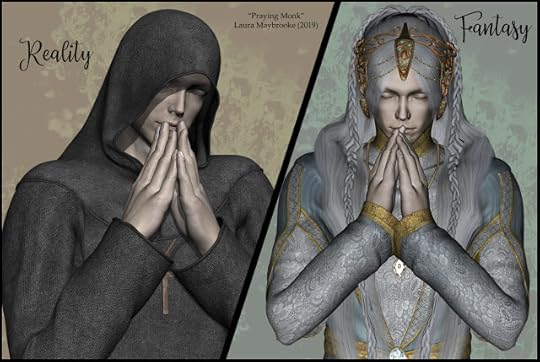
Writing fantasy gives us access to fantastical worlds—ones unburdened by the nitty-gritty details of reality. That is not to say a fantasy world can function without an internal logic system, but that one needs not always adhere to the small details of ancient everyday life.Today I am exploring the life of medieval monks—and by extension, showing how it contrasts with the life of my priests in my fantasy novel Immortal Defiance and its upcoming two sequels. In my fantasy novel, priests of Lordanys are dedicated monks, skilled at healing and herb lore, but many of them are also excellent fighters. An example of such a character in my novel is the high priest Myoden, an ally to the novel’s leading lady, the elven enchantress Dulcea. His position as a high priest likens him to an abbot of a medieval monastery. The priests’ powers are half magic, half hard work. They dress in fancy embroidered robes and can marry and have children, own worldly goods, and are free to leave the temple whenever.
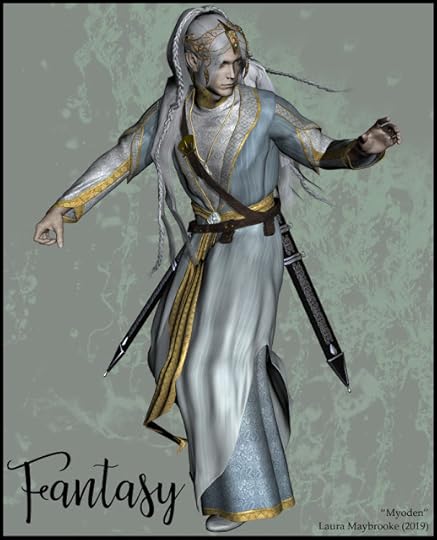
Quite different from the life of real medieval monks, would you not say?In medieval times, apart from some notable Irish exceptions, monks mostly lived and died within the walls of the monastery they had once joined as a novice. Their possessions were few: apart from a few sets of clothes, they usually only owned a comb, a small sewing kit, a pen, and a knife. Grooming equipment such as razors were only available at select times. The monks’ meagre possessions extended to their sleeping space: they often had only a straw-filled mattress and a few woolen blankets.The life of a medieval monk was one of constant work, whether physical or spiritual. Monasteries differed in size: the smallest had only a dozen or less inhabitants, while the larger ones could boast having over a hundred brothers. In France, in mid-12thcentury, the monastery of Cluny Abbey at its peak had 460 monks living there.The larger the monastery, the wealthier it normally was. Although people of any rank could apply to become a monk, many monks came from well-to-do families and provided the monastery with considerable riches. In the smaller monasteries, the monks sometimes needed to take care of all the chores of the monastery, including cooking, cleaning, and laundry. The larger, wealthier monasteries often attracted many lay brothers and could also afford to hire laborers for the manual work. Lay brothers, where available, lived within the monastery’s walls—together but separate from the monks—and adhered to some monastic regulations while doing manual labor for the monastery and on its lands.A monk’s duty was never-ending. Their daily life consisted of worship, prayer, meditation, reading, and manual labor. Breviary, the unabridged version of the more famous Book of Hours, divided into eight sections—or hours—was the monks’ main prayer book. It was read at eight specific times of the day in the monastery church, even during the night at 2 am and then again at 5 am. These occasions were known as follows: Matins, Lauds, Prime, Terce, Sext, Nones, Vespers and Compline.The monks’ dress was basic, made from the cheapest cloth, and they normally owned only two pieces of the same clothing. Their wardrobe consisted of linen underclothes, sometimes hose or socks, a simple woolen tunic, a cowl, and a robe. During winter, a sheepskin cloak provided extra warmth. Most monks received a new cowl and a robe each Christmas. A monk’s cowl, a long sleeveless robe with a deep hood, remains their most recognizable item of clothing to this day.
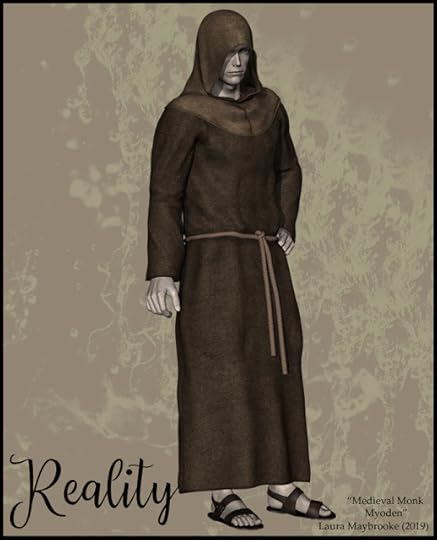
Like with the cowl, medieval monks’ other most remembered distinguishing feature relates to their appearance. Monastery rules required all monks to shave the top of their head. This distinctive haircut, called a tonsure, left their heads shaven except for a narrow strip of hair above the ears. For the monks, tonsures symbolized their renunciation of worldly fashion and esteem.As the Middle Ages progressed, different orders branched out from the Benedictine Rule practiced by the first medieval monks. Different orders had different practices, and some took vows of silence while others were not as strict. In general, though, all main orders subscribed to three essential vows: those of poverty, chastity, and obedience. Anyone breaking the monastic rules got reported to the abbot, and depending on the severity of the transgression, possible punishments included being beaten, exclusion from communal activities for a time, temporary imprisonment, or even expulsion from the monastery. What then compelled people to become monks? Why would people sometimes send their children to the monastery as young as at five years of age?Almost no one lived an easy life in the Middle Ages. The medieval world was rife with disease, famine, warfare, and violence. Even the most powerful monarchs were in constant danger of something uncontrollable upsetting their world. The life of a monk was hard, but unlike most other career options, it offered a secure roof over one’s head and above average quality and amount of food and drink for the duration of one’s life. As such, it is difficult to say how many became monks for the sole purpose of devoting their lives to serving God, and how many just to live life in a secure retreat, to escape from violence and warfare, or to lead a peaceful and quiet life.Monasteries contributed in an important way to the communities near them. Anyone joining the monastery could receive an education there, learning reading, writing, arithmetic, and Latin. The monks produced and copied books and illuminated manuscripts, travelers could find a room with them when needed, and they also helped the poor by providing medical care, orphanages, homes for the aged, and public baths. Monasteries were also great patrons of the arts and looked after many pilgrim sites.While monkhood was not always a permanent career choice, particularly from the 13thcentury onwards, most monks had no need or desire to leave the monastery after their acceptance into it. Because of this, monasteries were self-sufficient and provided its inhabitants with all the things necessary for survival, including education, food, spiritual sustenance, medical care, and barber services. The specific skills present in each monastery depended on the monks’ own training and interests. For more information on medieval monks and their everyday life and habits, start with Ancient History Encyclopedia:https://www.ancient.eu/article/1293/the-daily-life-of-medieval-monks/or Medieval Life and Times:http://www.medieval-life-and-times.info/medieval-life/life-of-medieval-monks.htmBoth of which sites were used to contribute to the content of this article, along with my own knowledge and impressions gathered throughout the years.
Immortal Defiance(Dulcea’s Rebellion #1)By Laura Maybrooke
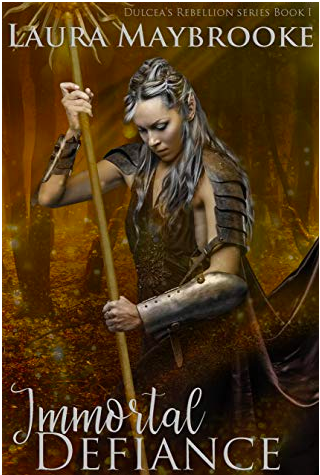
Some things never die. Hope. Heroes. Defiance.
Things take a strange turn for Dulcea, the elven enchantress turned war heroine and Dragonmistress, when a countryman's betrayal lands her in enemy hands.
As she awaits her execution, a stranger with mysterious powers offers her another chance at life. Will she die here or risk what sinister fate he has in store for her?
Can Dulcea reclaim her rightful place and lead her army once more? Or does Krath, the man who travels the Realm of the Dead as one of its own, prove to be the obstacle that fells her rebellion?
… Or will this immortal vampire warrior turn out to be the best chance she has of defying the ancient evil arising in the west?
Excerpt
Dulcea stared at the black ceiling, shivering from the cold of the underground. She attempted to recount all the important things in her life before it was to end when out of nowhere she heard a soft voice.“A damsel in distress.” To her confused surprise, the language spoken was Caerynian Common instead of Sarusean, the tone of the words fascinated. “A maiden sacrifice.”Dulcea thought she saw a shadow move from the corner of her eye, but when she turned her head to look there was no one there. For an instant, fear took her breath away.The seconds ticked by, but nothing happened. She saw no one.“Aren’t you going to ask who’s there?” the voice asked her after a moment, sounding amused.It was a man’s voice, deep and smooth—almost familiar, like something half heard in a dream.She drew in a shuddering breath. “Who are you?”“I could tell you my name, but it would mean nothing to you,” the voice said. “I can tell you whatI am instead: I am the beast that has come to collect you.”Her blood ran cold. The hair on her nape stiffened.Her throat felt raw. “Keep away from me!”“You are afraid. Good. You should be. Things do not look good for you.”Dulcea whipped her head from side to side, but still she saw no one. The voice seemed to come from a different direction every time it spoke. She could not tell if she was talking to a person under an invisibility spell or a disembodied spirit.“What do you want?”There came a soft, answering chuckle from somewhere nearby. “If only it were that easy. What do I want? The mind can want one thing, the heart another. Reason and instinct can both be at conflict. It is not so much about wanting as it is about choosing a path, and I have not yet chosen.”“Who do you serve?” He sounded different from the priests.“I serve no one.”“No. Everyone serves someone, even kings and emperors.”“I am neither a king nor an emperor, but I serve no one.”Dulcea froze. Fear entered her mind. She had the sudden dreadful premonition that perhaps she was already dead and talking to Asherac himself.“You refused to heed the counsel of your friends,” the voice said. “You ignored the caution advised to you, only to find yourself in this wretched place. How does that make you feel?”Her breath failed her. Dulcea wheezed, trying to calm the panicked fluttering of her heart.“I bet you have some regrets and would welcome a second chance.”The faintest hope stirred in her breast at his words. Perhaps he meant her no malice.“Yes…” Her tone was cautious. “I wish for a second chance.”“It is a vain wish. There are no second chances. All of us we only get one try, and if we fail, we must live with the consequences. You have failed. I am not here to rescue you. I am merely here to offer you a different kind of nightmare.”“What… what are you talking about?”“I cannot seem to choose on my own, so you must do it for me. Would you like to take your chances with me… or with them?”
The Coffee Pot Book Club
★★★★★Highly Recommended
Read the full review HERE!

Pick up your copy ofImmortal DefianceAmazon UK • Amazon US
Laura Maybrooke
 "I live in my own little world. But it's ok, they know me here." (Who besides me has this fridge magnet; raise your hand!)
"I live in my own little world. But it's ok, they know me here." (Who besides me has this fridge magnet; raise your hand!)That's sometimes what it feels like. Who says stories aren't real? I live in the land of the Midnight Sun and Polar Nights, together with my husband and daughter, and a cast of fantasy characters running around in my head. It's busy here. Care to stay and chat a while?
Laura Maybrooke is an 80s' child, who works too much and writes too little, but who'll never say no to a thrilling romance, a high fantasy adventure, or a cookbook full of delicious treats she'd like to bake one day.
Connect with Laura: Website • Facebook • Twitter • Pinterest.
Published on January 22, 2020 20:00
January 21, 2020
How Stendhal’s Syndrome fuelled my writing by Drēma Drudge #HistoricalFiction #amwriting @dremadrudge

How Stendhal’s Syndrome fuelled my writing.By Drēma DrudgeMy husband and I, both writers, were thrilled to be celebrating our twentieth anniversary in Rome. We adore art and everywhere we looked in the city were statues and paintings. It was heady. But as we moved about the art-laden St. Peter’s Basilica, suddenly we were before La Pieta, the statue of Mary and Jesus by Michelangelo. In all of the wonders we had seen, I had forgotten it was at the Basilica. Without realizing it, upon seeing it I swayed, and my husband had to catch me and lead me to a bench. I was overcome with wonder and awe. This wasn’t the first time this had happened to me in a museum, but when we got home, I began doing some research to finally figure out why. It turns out I suffer from Stendhal’s Syndrome.
 La Pieta.
La Pieta.Stendhal’s Syndrome was named after the French author Marie-Henri Beyle, who used the pen name Stendhal. He wrote about his unexpected episode of euphoria while visiting Florence in 1817. He described feeling ecstatic, having visions, and heart palpitations in the presence of art from just being in the city of some of the world’s greatest artists.
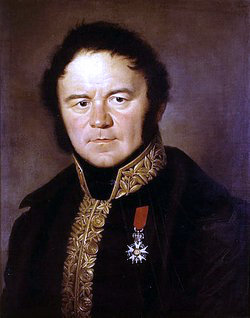 Stendhall.
Stendhall.Though the phenomenon has been observed for quite some time, it was only named in 1979 by a doctor who had treated numerous patients with it in Florence, a capital of art and architecture. More recently, according to Wikipedia, in 2018 a man was so overcome by seeing the Botticelli’s The Birth of Venus that he had a heart attack. While I have been fortunate enough not to have had a heart attack, I have suffered with the other symptoms of Stendhal’s Syndrome: confusion, feeling faint, agitation, and a rapid pulse. There is some disagreement in the psychological community as to whether it truly exists, but since it happened to me without me even knowing it existed, I’d say that’s proof of a sort. Those who do see it as a legitimate condition think there is some connection between viewing art and the emotions. Medical staff in Florence in particular are accustomed to treating affected art viewers. For me, the experience is blissful. There’s nothing that feels like being overwhelmed and overtaken by a work of art. When I saw Michelangelo’sDavid in Florence for the first time, I wasn’t expecting what happened. I felt faint. I cried copiously, not wanting to leave. In that state of mind I wondered how I could move to Florence so I could become a caretaker of David, so that I could ensure he was cared for properly. (There is no rationality to Stendhal’s Syndrome.). Eventually I was convinced by the tour guide that, tears and all, I must move on, but I was unhappy to leave and made no secret of it.
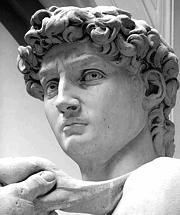 David.
David.These feelings have happened to me, too, in Chicago at the Art Institute, in Toledo while viewing a Manet exhibition, and, as I said, in front of David, though I suppose that makes me a Stendhal’s Syndrome cliché.At the Art Institute, I was stricken by Henri Matisse’s painting of Olga Meerson, a woman who turned out to be a painter herself. Based on this experience, I wrote a short story about her which became my first published fiction. It was published in a literary journal, and I was thrilled that this thing that could have just been embarrassing had become positive to my writing. My extreme zeal for art has continued to fuel my work. My first novel is about such an artwork: Olympia, by Edouard Manet, a painting that struck me still in Paris and demanded to be looked at until I had memorized nearly every stroke. I felt compelled to learn more about the painting, about the model, and that led to my novel. I’m grateful for the inspiration, and I have a whole host of topics following that one to write about.
 Olympia.
Olympia.When I suffer an “art attack,” I often want to write more and examine the object of art more to see what it is that has overtaken me. Why did I have that reaction to that piece of art? It leads me to a world of writing that I can get lost in. I enjoy it. I’m not sorry at all to have such strong reactions to art, though I do sometimes warn those I’m going with if they haven’t seen it happen to me. And it doesn’t always happen. It’s unpredictable, though if I’m excited ahead of time about what I anticipate seeing, chances are more likely I will react. Art fuels my writing. I’ve learned to appreciate my extreme affinity for it. It’s like being in love, but while standing on the ledge of a very tall building. My heart pounds; sometimes I cry. I feel faint, overwhelmed. I have to leave the area until I compose myself and then I return and remain rooted until forced to move on. And yet I’m irresistibly drawn back to whatever work of art is moving me, whether in person or online until I’ve processed it, usually by writing. Sometimes I have to stare at photos of it or talk nonstop about it. Since this has already given me a short story and a novel, not to mention tons of ideas, I’m grateful for Stendhal’s Syndrome, and I’d argue it certainly exists.
 Drema and her husband, Barry, in front of the Trevi Fountain.
Drema and her husband, Barry, in front of the Trevi Fountain.Victorine
By Drema Drudge

In 1863 Civil War is raging in the United States Victorine Meurent is posing nude, in Paris, for paintings that will be heralded as the beginning of modern art: Manet s Olympia and Picnic on the Grass. However, Victorine s persistent desire is not to be a model but to be a painter herself. In order to live authentically, she finds the strength to flout the expectations of her parents, bourgeois society, and the dominant male artists (whom she knows personally) while never losing her capacity for affection, kindness, and loyalty. Possessing both the incisive mind of a critic and the intuitive and unconventional impulses of an artist, Victorine and her survival instincts are tested in 1870, when the Prussian army lays siege to Paris and rat becomes a culinary delicacy.
Excerpt
I am called The Shrimp, Le Crevette because of my height and because I am as scrappy as those little question-mark-shaped delights that I used to study when my father took me to Les Halles. I would stand before the shrimp tank and watch the wee creatures paw at the water, repeatedly attempting to scale the tank, swimming, sinking, yet always rising again. I hoped eagerly for one to crest the tank, not realizing until later that the lid was there precisely to prevent their escape.
So why am I reminded of that tank today? Today, while I am giving a guitar lesson in my father’s lithography shop, the gifted yet controversial painter, Édouard Manet, enters the shop. He gives me the nod.
I cover the strings of my guitar with my hand to silence them. Pѐre has mentioned Manet’s recent patronage of his shop, of course, but I have never been here when the artist has come by.
"M. Manet, this is my daughter, Victorine. I believe you’ve. . . ."
"We've met," I say.
"And where is it we have met, Mademoiselle?" he asks, wincing as he looks in the vicinity of my nose.
Is this a snub? I run my hand over the swollen, crooked lump of flesh on my face.
"I must be mistaken." I turn away, smiling bitterly at my quick temper, at my trying to turn up a nose such as this. Of course he doesn’t recognize me.
I motion for my student to put her guitar away: “That’s enough for today, dear.” Though she looks at the clock with a puzzled brow, she does as I say.
My father graciously allows me to give lessons in his shop, claiming he loves to hear young musicians learning to play, though I suspect it’s more because my mother hates allowing anyone into our house besides her regular millinery clients.
Manet moves toward me, puts his face close to mine; I don’t pull away, but only because that is the way painters see. I would have punched another man for standing so close. He snaps his fingers. "Le Crevette?” he exclaims, backs away. I raise my chin to regard the posters on my father’s wall. The Compagnie Francaise de Chocolats et des thes declares my father’s fine sense of color, his signature mingling of coral and scarlet. The other posters reveal his repeated twinning of these colors.
Manet grasps my hand with frank friendliness that I almost believe. Want to believe. "It is you; I’ve seen you model at Coutoure’s. But what has happened to your nose?"
I rise on my toes, though the height it gives me is minimal. I motion for Gabrielle to gather her music, and she shuffles the sheets.
I move closer to him while withdrawing my hand from his, take out my emerald green enamel cigarette case (a gift from a wealthy student at Coutoure’s studio) and light a cigarette. I empty my lungs straight at the yellowing ceiling, though my torso is not a foot from his.
My father frowns and waves the smoke away; how many times must I tell him that I am eighteen and I will smoke if I please? He smokes a pipe sometimes. What’s the difference?
"I give guitar lessons now. Obviously, I'm no longer a model."Manet’s eyes graze on me. I stand straighter. When I realize it, I relax.
"I know just how I’ll paint you. Shall we say tomorrow at one?"
My father runs his grungy shop cloth through his hands.
I raise my chin, art lust in my eyes.
"We shall say two."
He crooks his eyebrow. "Wear something else, will you? That frock does nothing for your apricot skin tone, much less your eyes. And wear your hair down…." He touches a section of my red hair that flows forward, and I jerk away. “No. Better wear it up.”
I glance down at my mud-colored calico dress, pick up my guitar case and make to lead my young charge out the door.
“Meurent?” he says. I smile, erase it before turning back.
“Do you know where my studio is?”
“You may leave your card with my father.”
I am well aware of the opportunity I have been offered. If it weren’t for this trouble with Willie, I would be ecstatic. As it is, I am just a flicker beyond moved.
Pre-Order your copy ofVictorineAmazonRelease Date March 17, 2020
Drema Drudge
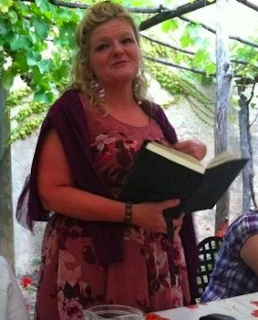 Drēma Drudge suffers from Stendhal’s Syndrome, the condition in which one becomes overwhelmed in the presence of great art. She attended Spalding University’s MFA in Creative Writing Program where she learned to transform that intensity into fiction.Drēma has been writing in one capacity or another since she was nine, starting with terrible poems and graduating to melodramatic stories in junior high that her classmates passed around literature class.She and her husband, musician and writer Barry Drudge, live in Indiana where they record their biweekly podcast, Writing All the Things, when not traveling. Her first novel, Victorine, was literally written in five countries while she and her husband wandered the globe. The pair has two grown children.In addition to writing fiction, Drema has served as a writing coach, freelance writer, and educator. She’s represented by literary agent Lisa Gallagher of Defiore and Company.
Drēma Drudge suffers from Stendhal’s Syndrome, the condition in which one becomes overwhelmed in the presence of great art. She attended Spalding University’s MFA in Creative Writing Program where she learned to transform that intensity into fiction.Drēma has been writing in one capacity or another since she was nine, starting with terrible poems and graduating to melodramatic stories in junior high that her classmates passed around literature class.She and her husband, musician and writer Barry Drudge, live in Indiana where they record their biweekly podcast, Writing All the Things, when not traveling. Her first novel, Victorine, was literally written in five countries while she and her husband wandered the globe. The pair has two grown children.In addition to writing fiction, Drema has served as a writing coach, freelance writer, and educator. She’s represented by literary agent Lisa Gallagher of Defiore and Company.Connect with Drema: Website • Twitter • Instagram • The Painted Word Salon.
Contact me at drema@dremadrudge.com if you’d like me to speak at your event, class, or book club, either in person or by Skype.
Published on January 21, 2020 20:00
January 20, 2020
FEAST YOUR EYES ON THIS! #HistoricalFiction author, Brooke Allen, is taking a look at the delicacies that graced the Roman Table #History #AncientRome @1BrookAllen
FEAST YOUR EYES ON THIS!Delicacies that graced the Roman TableBy Brook Allen

As we begin 2020, many of us will be beginning the usual New Year’s resolution diet. In honor of this, I thought it might be interesting to discuss Roman foods. And the first thing I'll say about them is that ancient tastes were MUCH different than those of today. In fact, just reading about them may help you stick to your resolution!
Here is a listing of some preferred delicacies gracing the noble Roman table. Not all of them were bizarre, but I think it's safe to say that most people today might crinkle their noses at the mention of a few.
DORMICE : Yeah... as in MICE. The Romans actually farmed these little rodents, as they were considered such a delicacy. They were fattened with nuts, often served stuffed with pine-nuts, meats, or grains, then roasted. Sometimes they were dipped in honey, like a chicken nugget. According to Wikipedia, they're still considered yummy in places like Slovenia and Croatia. Thanks, but I'll stick with chicken.
FLAMINGO TONGUES : Actually, the entire bird was considered to be a fabulous course at banquets among the elite. However, the tongues of flamingos were the cats meow. They have a meaty surface that Romans simply loved. And apparently, they tasted fantastic! I'm still sticking with chicken.
GARUM : Garum was the ketchup of the Roman world. It was a fermented fish sauce, and since I happen to love fish, I thought (at first) that here was something I would give a try. However, after some research, I discovered that garum was made using fish intestines, and now I'm back to plain old chicken, again. Still, garum was popular not only in Rome, but the Greeks had already developed a form of it, and later on, the Byzantine people adored the stuff. There are many examples of amphorae (pottery vessels) that were used to store garum, and traces of the substance have even been discovered in Pompeii.
JELLYFISH : Even though I'm sticking with chicken, many Asian societies still eat jellyfish, and so did the Romans. One popular way of serving it was to prepare it with eggs, according to Marcus Gavius Apicius, a foodie during the reign of Tiberius. Apicius left the world a good many recipes and from his writings, we are left with a great deal of information on eating habits in the Roman world.
EEL : Just like dormice, eels were often farmed and considered haute cuisine. In fact, they are still very popular in Asian cooking. However, if you were a Roman who (like me!) wouldn't stomach eating one, then it was much in vogue just to keep them as pets! In fact, Marc Antony's daughter is said to have owned a pet eel that she adorned with earrings! Julius Caesar, however, may have had a taste for eels. Two commentaries record that he purchased either two-thousand of the slimy snacks (according to Varro) or six-thousand (according to Macrobius) to feed the populace during his Triumphs.
ICE CREAM : Yes, Romans enjoyed sweets. A sort of "iced-cream" was often served as a dessert, mixed with snow from the mountains, along with milk, cream, honey, nuts, and dates.

If you're interested in more information on cuisine and feasting in the ancient world, several cookbooks based on foods in the ancient world are now available, translated from original recipes. I have one in my own cookbook collection. The Classical Cookbook by Andrew Dalby and Sally Grainger is loaded with recipes and intriguing information on things the ancients ate.
Bon appetit and good luck on the diet!
Antonius: Second in Command
By Brook Allen
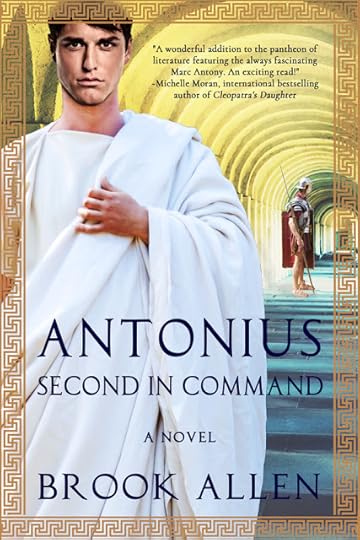
The Antonius saga continues…
Having proven himself as a formidable cavalry commander, Marcus Antonius finally earns a position at his kinsman Julius Caesar’s side. However, Caesar is an exacting general, demanding complete allegiance from his staff, even when his decisions put him at odds with the Senate. Marcus’s loyalty to Caesar comes at a cost, and he soon finds himself embroiled in mob violence and military mutinies. As civil war brings Rome’s Republic crashing down, many a relationship is torn asunder, including Marcus’s marriage. Determined to rise triumphant in Rome’s new era, Marcus faces his fears, his failures, and his enemies—not the least of whom is himself.
Amid the crisis of the Ides of March, Marcus must don the mantle of ruthlessness to carve his own legacy in Rome’s history. Enemies have been made, wills have been read, and heirs proclaimed.
But in Rome’s civil unrest, blood answers only to blood.
Amazon
Antonius: Son of RomeBy Brook Allen
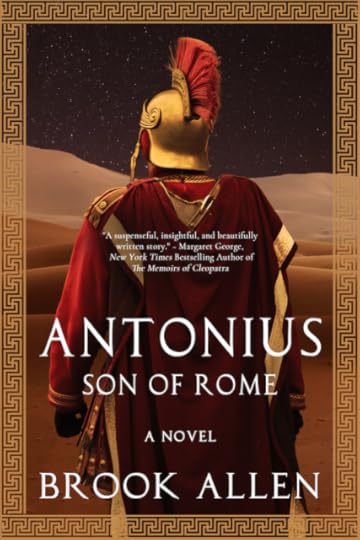
For over two thousand years, Marc Antony has been one of history’s most controversial men. His story was buried with him and written by his enemies. Now his entire saga is revealed in a compelling trilogy by Brook Allen.
After young Marcus Antonius’s father dies in disgrace, he yearns to restore his family’s honor during the final days of Rome’s dying Republic. Marcus is rugged, handsome, and possesses abundant military talent, but upon entering manhood, he falls prey to the excesses of a licentious society. His whoring, gambling, and drinking eventually reap dire consequences. After a series of personal tragedies, Marcus must come into his own through blood, death, and sacrifice. Once he finally earns a military commission, he faces an uphill battle to earn the respect and admiration of soldiers, proconsuls, and kings. Desperate to redeem his name and carve a legacy for himself, he refuses to let warring rebels, scheming politicians, or even an alluring young Egyptian princess stand in his way.
Amazon
Brook Allen
 Brook Allen is a Music Educator in a rural community near Roanoke, VA. Aside from her regular classes, she teaches two ensembles, a Chorus and Recorder Consort. Born in Salt Lake City, UT, Brook was raised in Omaha, Nebraska and has lived all over the U.S., from the Pacific Northwest, all the way down to Florida. She graduated with a B.A. in Music Education and has a M. A. in Liberal Studies, with an emphasis on Roman History. Brook is happily married and has two energetic Labrador Retrievers. Voraciously active, she cycles, hikes, and loves to travel.Connect with Brook: Website • Twitter • Facebook.
Brook Allen is a Music Educator in a rural community near Roanoke, VA. Aside from her regular classes, she teaches two ensembles, a Chorus and Recorder Consort. Born in Salt Lake City, UT, Brook was raised in Omaha, Nebraska and has lived all over the U.S., from the Pacific Northwest, all the way down to Florida. She graduated with a B.A. in Music Education and has a M. A. in Liberal Studies, with an emphasis on Roman History. Brook is happily married and has two energetic Labrador Retrievers. Voraciously active, she cycles, hikes, and loves to travel.Connect with Brook: Website • Twitter • Facebook.
Published on January 20, 2020 20:00
January 19, 2020
Check out the cover of Rachel Ann Smith's fabulous upcoming release — Visions of Lady Mary: Agents of the Home Office #3 #HistoricalRomance @rachelannsmit11

Visions of Lady MaryAgents of the Home Office #3By Rachel Ann Smith
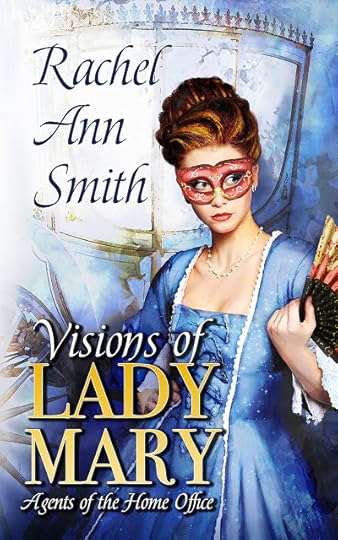
It’s hard to connect with the living when you’re able to communicate with the dead.
Shipped off to the Continent, Lady Mary Masterson is determined to make the most of her time in France—especially when the man who once called her a witch turns up to meet her upon her arrival. If only she could ignore the effect he has on her fluttering heart and the voices who constantly harp on the advantages of marrying the man.
Battlefield promises are easy to make and hard to keep.
Gilbert Talbot, the Earl of Waterford, may have promised Mary’s dying brother to care for her, but that didn’t stop him from avoiding the woman whose mere presence causes every cell in his body to come alive. Fate has once again placed Mary in Gilbert’s path, only this time, he is on a dangerous mission.
When secret agreements are revealed, will Mary flea or accept her destiny?
Visions of Lady Mary is part of the Agents of the Home Office regency romance series. If you like unconventional heroines, heroes head over heels in love, and romance with a hint of mystery, then you’ll adore Rachel Ann Smith’s quick paced novels.
Pick up your copy ofVisions of Lady MaryAmazon
Rachel Ann Smith
 Rachel Ann Smith writes steamy historical romances with a twist. Her debut series, Agents of the Home Office, features female protagonists that defy convention. When Rachel isn’t writing, she loves to read and spend time with her family. She is frequently found with her Kindle by the pool during the summer, on the side-lines of the soccer field in the spring and fall, or curled up on the couch during the winter months. She currently lives in Colorado with her extremely understanding husband and their two very supportive children.Connect with Rachel Ann: Website • Facebook • Twitter • Instagram • BookBub • Amazon.
Rachel Ann Smith writes steamy historical romances with a twist. Her debut series, Agents of the Home Office, features female protagonists that defy convention. When Rachel isn’t writing, she loves to read and spend time with her family. She is frequently found with her Kindle by the pool during the summer, on the side-lines of the soccer field in the spring and fall, or curled up on the couch during the winter months. She currently lives in Colorado with her extremely understanding husband and their two very supportive children.Connect with Rachel Ann: Website • Facebook • Twitter • Instagram • BookBub • Amazon.
Published on January 19, 2020 20:00
January 16, 2020
#HistoricalFiction author, Heidi Gallacher, is sharing an excerpt of he fabulous book — Rebecca’s Choice #mustread @HeidiGallacher

Rebecca’s ChoiceBy Heidi Gallacher

The year is 1894. Her husband is dead. Her husband’s best friend has offered to marry her to keep her in the style to which she is accustomed. But, this isn’t what she wants. It isn’t, at all …
Excerpt
I think of my children and how they are missing their papa. Sometimes I hear them calling out for him in the night. I must consider them more. How can my waking thoughts be suffused by Reece when my own children are suffering…? I have to stop thinking about him.
I hear the slight crack of a twig outside and the sound of a cough. His cough. My body grows tense, for I know what will happen, as surely as a mother bird will care for its young or the waxing moon will pull on the tides. I must try to resist with every ounce of my being.
I stand up. As the handle of the door starts to turn, I gather my skirts around me.
He enters the little room, wrinkling his brow as he sees me. ‘Oh, er…Mrs. de Roussier… I have come to take the readings. I was unable to do so yesterday due to the inclement weather. I did not expect…’
‘Oh no, that’s quite all right, thank you for coming. I was just sitting here alone. I was thinking about my children, about how they are missing their father.’‘It must be very difficult for them. He was taken away from them so suddenly.’ Reece’s green eyes mist as he remembers. ‘Geoffrey was my mentor. He taught me so much about all these.’ He gestures to the instruments standing and hanging around us.
I look along the wall to where he is pointing. ‘I do wish that I knew more about them. I come here to polish them…but I don’t really understand them at all. Geoffrey wouldn’t answer my questions. He would say that he didn’t have the time.’
Reece smiles and beckons me to follow. ‘Then let us begin now. We will start with this one, I think it is the most beautiful.’ He looks at me. He is standing by the barometer that I have just polished, its glass and wood gleaming.
I move over to him and peer at the instrument. There is still a scent of wax and lemon, but beneath it all I can discern his sweet aroma.
‘This is what I call a friendly instrument, since it shows you exactly what is happening.’ He moves his long, slim fingers across the dial.
‘Yes,’ I murmur. I want to kiss them, one by one. Instead, I read out loud, ‘Fair, stormy, mainly dry. Please, tell me how it works.’
He indicates the long, thin tube above the dial. ‘The liquid in here is mercury. More than two hundred years ago, scientists found that the height of mercury when in a tube like this changed slightly each day. They discovered that this was due to the changing pressure of the air.’
‘What do you mean, the pressure of the air?’
‘Right. Well, think for a moment of the sea. If you swim down deeply you would soon feel the weight of the water pressing upon you. Now, consider this. Think of the sky outside and try to imagine the weight of the atmosphere—’
‘That’s silly! Air doesn’t weigh anything!’
‘Ah, but it does!’ Reece looks at me, his eyes gleaming. ‘The sky might look like a vast emptiness, full of little else but wispy clouds – but it still has weight! The air is pressing on your body, all around it – even now as we speak.’
I take a step back and look down at my body, patting it here and there.
Reece smiles and his cheeks redden slightly. ‘You won’t feel it – but I assure you that it is happening.’
I look up. ‘So, that is what’s happening with the mercury? This pressure of the air forces it up the tube?’
Reece claps his hands. ‘Yes! And the higher the pressure, the more the mercury rises.’
I consider for a moment. ‘So we know if the air pressure is high or low.’
‘Yes. And due to this we can forecast changes to the weather. Or attempt to. If the pressure is low, that generally indicates stormy weather. High pressure is the opposite, indicating better weather. Like to-day.’ He looks across to the window. ‘Here, at Tredelerch, an average reading would be around thirty inches.’ He indicates the scale next to the tube. ‘To-day’s reading is thirty point two.’
I touch the dial beneath the tube, which is pointing to ‘Fair’. I say, ‘And the dial agrees! So how does the dial work?’
‘Yes, the dial shows the same thing. But a word, rather than a number. They add it to make it easier to read; not everyone is a scientist. Behind it there is a little spring attached to a box. When the pressure rises or falls, the box moves in and out in response. The spring expands or contracts and moves the pointer on the dial. As the pressure is high, it is pointing towards “Fair”.’
I nod. ‘I can see…thank you. I think I prefer the dial, it does make it easier to read the weather.’ I can feel the warm rays of the sun streaming through the little window, warming my back. ‘And it most certainly is sunnier to-day.’
‘Ha, I agree. Now, to finish our lesson, we are going to look at this old fellow, hanging over here.’
‘Oh, that’s the thermometer; I understand how that one works.’
Reece winks at me. ‘Are you sure? Come and look with me. I bet that you don’t know everything…’
I move to his side. His fragrance drifts to me again. I close my eyes, then force them open again. I try to focus on the thermometer.
‘What do you think the liquid is, inside?’
‘It’s mercury…like in the barometer.’
‘Mercury again. But why use mercury? Why not silver?’
‘Wouldn’t silver be too dear?’
‘It would; you are right. But there is a very important reason why mercury is used.’
‘Tell me.’
‘Mercury is a rather special metal. It is liquid, not solid, at ordinary room temperatures. Silver is solid. When the mercury gets hotter, it expands and moves up the scale. And it expands a lot, so any changes are easy to detect and read.’
‘That is so interesting, Mr. Lyons,’ I murmur. I am fascinated by what he says, how he answers my questions, by what he knows. I know that it will mean so much more to me now, when I consult these beautiful instruments and take their readings.
‘Should I tell you some more?’ He looks at the thermometer again, running his fingers along the scales on either side of the mercury. As he draws his hand back, it brushes against my arm; once again I feel his warmth. He turns to look at me.
I say nothing, as I am unable. I turn to him and close my eyes. I can hear his breathing, the warm air gentle on my cheek. He moves to me, and I feel the softness of his skin as his lips caress my own. After a long, long while we pull apart. He moves a strand of hair gently away from my eyes. We regard each other.
‘I knew from the moment I saw you again, but I felt I had to wait…’
‘Yes. We had to wait. I felt ashamed to have these feelings about you so soon after…’ I hesitate and then trace the outline of his lips with my finger. ‘It has been an agony of longing.’
‘Shh…’ He strokes my face, and I close my eyes once more.
‘I am so glad that we have found one another.’
Pick up your copy ofRebecca’s ChoiceAmazon UK • Amazon US
Heidi Gallacher
 Heidi Gallacher was born in London in the Sixties. She grew up in Cardiff and Swansea, South Wales. She jumped at the chance to move to Paris in her twenties to learn a new language and culture. Following the arrival of her first son she moved to sunny Switzerland where she has lived ever since. She completed her Masters in Creative Writing in 2018 and her first short story Changing Places was published in September of that year. Rebecca’s Choice is her first novel.
Heidi Gallacher was born in London in the Sixties. She grew up in Cardiff and Swansea, South Wales. She jumped at the chance to move to Paris in her twenties to learn a new language and culture. Following the arrival of her first son she moved to sunny Switzerland where she has lived ever since. She completed her Masters in Creative Writing in 2018 and her first short story Changing Places was published in September of that year. Rebecca’s Choice is her first novel.When not writing, Heidi writes and performs music, swims in Lake Zürich and fundraises for Africa.
Connect with Heidi: Facebook • Twitter • Goodreads.
Published on January 16, 2020 20:00
January 15, 2020
January 14, 2020
#BookReview — Dread Pirate Arcanist (Frith Chronicles #2) by Shami Stovall #YoungAdult #Fantasy @GameOverStation
 Dread Pirate Arcanist (Frith Chronicles #2)By Shami Stovall
Dread Pirate Arcanist (Frith Chronicles #2)By Shami Stovall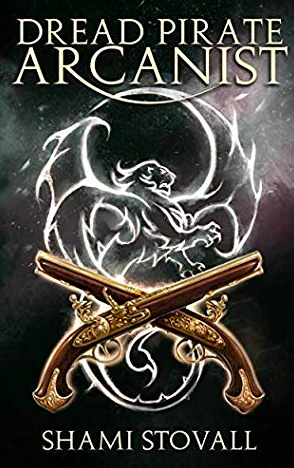
Pirates. Griffins. A lost treasure worth killing for.While protecting the newborn griffins on the Isle of Landin, Volke Savan and his adopted sister, Illia, run afoul of the Dread Pirate Calisto, the same cutthroat who carved out Illia’s right eye. As a master manticore arcanist, Calisto’s strength and brutality are unrivaled, so when Illia suggests they bring him to justice, Volke wonders if they’ll have what it takes to fight the corsairs on the high seas.

“End me while I can still comprehend the magnitude of my crimes...”
Luthair, a mythical creature known as a Knightmare, lived within the darkness, and sometimes so did Volke Savan, but as the young arcanist sat on the rocky cliff looking out over the Isle of Landin, Volke had no knowledge about how dark this day would become and what it would mean for a regal Griffin, his friends, his sister, and the man whom he was apprenticed to — Master Zelfree.
When the alarm was raised that the majestic Griffin ruler, Ryllin, was missing along with one of his children, Volke was, as all of his fellow arcanists were, keen to help. But when Volke finds Ryllin, things take a very sinister turn. For Ryllin has had an encounter with a Dread Pirate, but not just any Dread Pirate. He had encountered Calisto — captain of the feared Third Abyss.
Illia, Volke’s adoptive sister’s, knew all about Calisto, for that man had murdered her parents and taken her eye. Illia wanted vengeance, she wanted revenge, and she wanted Volke to help her.
But Volke knew that if they went after Calisto, it would be them that died, for Calisto was not given the title of Dread Pirate because of his hospitable personality. Convincing Illia, however, to leave the pirate well alone was a fight that Volke feared he would lose.
From a windy day upon the Isle of Landin to a daring rescue which could kill them all, Dread Pirate Arcanist (Frith Chronicles #2) by Shami Stovall is the enthralling story of Volke Savan and his desperate battle to not only stay alive but to keep Illia and his friends alive as well, in the face of impossible odds.
I was utterly enchanted with Knightmare Arcanist (Frith Chronicles #1), and I could not wait to find out what happened next to Volke Savan. Well, Stovall has done it again, Dread Pirate Arcanist was everything I had hoped it would be, and then some. It is in all ways an undeniable success.
Not only has Stovall penned a book that is so utterly enchanting that at times I lost myself so thoroughly that I forgot where I was, but she has also written a book where the realism is almost tangible. The magical world, which is fit to bursting with every conceivable mystical creature, has been written with an impressive sweep and brilliance. I loved every word, every sentence, every syllable. Dread Pirate Arcanist is a brilliant novel from start to finish.
From the backdrop to the characters themselves, this novel is as rich in detail as it is in adventure. Stovall has inked a wild yet strangely familiar landscape in which to set her story, and she has given her readers such a diverse range of characters to root for, that there really is something for everyone in this book. And although Dread Pirate Arcanist is written with the Young Adult audience in mind, I feel that this book, this series, is one that an adult audience would enjoy as well. I know I did!
Volke, whose leads this story through the cleverly crafted first-person narrative, is a character a reader can certainly get behind. He is honest, open and kind. Volke is also at times, painfully shy, especially when it comes to the opposite sex, which made him incredibly endearing. Volke is also the kind of character that inspires trust. Even Master Zelfree shares things with Volke that he has not shared with anyone else. I adored Volke in the first book of this series, and he has continued to capture my attention and my heart in the second.
We learn more about Volke’s “sister,” Illia, in Dread Pirate Arcanist. Illia has a traumatic past which culminated with the murder of her parents and the loss of her right eye. Illia has many reasons to hate, and her anger and her desire for revenge is understandable, but unlike Volke, who overthinks and hesitates before he acts, Illia has no such obstacles in her way. Illia is confident of her abilities, but her judgement is often clouded by her desire for revenge, and because of this, her relationship with Volke changes during the course of this book. She directs her anger at him when really, she is angry with herself and her own inability to achieve what she so desires, which I thought was very moving. Volke is, however, Illia’s one constant in a world that she does not understand. Through her actions and Volke’s interpretation, it is apparent that her feelings for Volke have also changed. She no longer considers him her brother, and although Volke does as he always does, and overthinks their situation, Illia does not. They are not siblings. They were two lost souls who were brought together by luck and circumstance when they were children. I am looking forward to seeing how Volke and Illia’s relationship changes and develops throughout this series.
Another character that I felt I got to know more about in this story is Master Zelfree. Master Zelfree is a master arcanist of The Frith Guild. On the first encounter, Master Zelfree came across as a drunk. He is abrupt. He is rude and yet, this front he puts on hides a broken heart and a shattered soul. I loved Stovall's depiction of Master Zelfree. He is a character that has certainly captured my fascination. He is courageous. He is willing to sacrifice himself. He is a very noble, and a very kind man who is stumbling his way out of the darkness of his grief and daring to live again.
There are several extraordinary magical creatures in this book — from the noble Ryllin to the plague-ridden gargoyle. With the inclusion of Dread Pirate Calisto and his crew, Stovall introduces her readers to some very dark mythical creatures. The Wendigo, with its frosty presence, is the thing of nightmares. It appears malnourished, but the Wendigo’s hunger is never satisfied. Likewise, Calisto’s eldrin, the Manticore, is a genuinely terrifying beast whose powers are immense and seemingly unstoppable — a worthy eldrin for Calisto and his blood-thirsty crew.
Another mythical creature that captured my attention but for all the right reasons was Master Zelfree’s eldrin, Traces, a shape-changing Mimic. In her natural form, Traces is cat-like, but she can mimic jewellery and any of the mythical creatures, which makes Master Zelfree quite powerful, but it, in turn, makes Traces very vulnerable. I adored Traces. She is a sweet-natured creature who is utterly devoted to Master Zelfree. I loved reading about Traces. You never knew what she was going to turn into next!
Although Dread Pirate Arcanist (Frith Chronicles #2) stands firmly on its own two feet, you would be doing yourself a disservice if you did not start with Knightmare Arcanist (Frith Chronicles #1). The first two books in this series have an awful lot to recommend them, and I, for one, cannot wait to get my hands on Book #3. Stovall has mastered the art of writing thoroughly enchanting stories.
I Highly Recommend.
Review by Mary Anne Yarde.The Coffee Pot Book Club.
Pick up your copy ofDread Pirate ArcanistAmazon UK • Amazon US
Shami Stovall
 Shami Stovall relies on her BA in History and Juris Doctorate to make her living as an author and history professor in the central valley of California. She writes in a wide range of fiction, from crime thrills to fantasy to science-fiction. Stovall loves reading, playing video games, entertaining others with stories, and writing about herself in the third person.
Shami Stovall relies on her BA in History and Juris Doctorate to make her living as an author and history professor in the central valley of California. She writes in a wide range of fiction, from crime thrills to fantasy to science-fiction. Stovall loves reading, playing video games, entertaining others with stories, and writing about herself in the third person.Connect with Shami: Website • Twitter • Facebook • Goodreads.
Published on January 14, 2020 21:00
Check out Historical Fiction author, Sam Taw's, fabulous book — Pagan Death #AncientHistory @samtawauthor
Published on January 14, 2020 20:00
The Coffee Pot Book Club
The Coffee Pot Book Club (formally Myths, Legends, Books, and Coffee Pots) was founded in 2015. Our goal was to create a platform that would help Historical Fiction, Historical Romance and Historical
The Coffee Pot Book Club (formally Myths, Legends, Books, and Coffee Pots) was founded in 2015. Our goal was to create a platform that would help Historical Fiction, Historical Romance and Historical Fantasy authors promote their books and find that sometimes elusive audience. The Coffee Pot Book Club soon became the place for readers to meet new authors (both traditionally published and independently) and discover their fabulous books.
...more
...more
- Mary Anne Yarde's profile
- 159 followers



